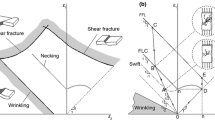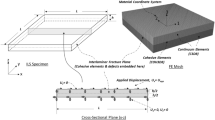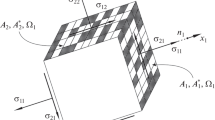Abstract
In the present paper a sheet of material is considered. It is loaded by uniaxial tensile stress and contains a random distribution of flaw orientations, with the flaws thought of as flat pre-cracks of comparable length, and with all crack planes being oriented perpendicular to the faces of the sheet. Intuition suggests that the most likely flaw to initiate fracture, which will be termed the “most dangerous defect”, lies orthogonally to the major load axis. The purpose of the present paper is to show that such an assumption is incorrect. Neither the most dangerous defect nor the first increments of crack growth will be oriented perpendicularly to the stress direction (nor will they be co-planar with the orientation of the most critical flaw).




Similar content being viewed by others
Notes
The process of cracking in continuum bodies reveals three well defined phases: loading without crack growth, stable crack growth, and unstable crack growth. If crack elongation is totally prevented the safety factor is measured against the load that allows the stable crack growth propagation phase to begin. Such a transition point is termed onset of crack propagation, whereas loading without crack growth happens in the safe equilibrium domain.
Let \(t\) represent any variable which monotonically increases in physical time and merely orders events; the mechanical phenomena to study are time-independent. The global incremental quasi-static fracture propagation problem at time \(t\) depends on the geometry at time \(t\) as well as on the actions that drive the problem itself, as external loads, self equilibrated stresses due to diffusion of species, thermal loads, fatigue, environment changes.
In Eq. (1.4), \(E\) is Young modulus and \(\nu \) Poisson’s coefficient.
The dependence is only on \(\omega \), since the “condition” has made \(\theta \) a function of \(\omega \).
Equivalently, it is the one for which the flaw leaves the state of safe equilibrium for the first time in the loading process \(\kappa (t)\).
References
Aifantis KE, Huanga T, Hackney SA, Sarakonsri T, Yua A (2012) Capacity fade in sn-c nanopowder anodes due to fracture. J Power Sour 197:246–252
Amestoy M, Leblond JB (1992) Crack paths in plane situations—ii. Detailed form of the expansion of the stress intensity factors. Int J Solids Struct 29:465–501
Barenblatt GI (1959) On equilibrium cracks forming during brittle fracture (in russian). Prikladnaya Matematika i Mekhanika 23:434–444 [See also, The mathematical theory of equilibrium cracks in brittle fracture, Adv Appl Mech 7:55–129 (1962)]
Bourdin B, Francfort G, Marigo JJ (2008) The variational approach to fracture. Springer, Berlin
Broberg KB (1999) Cracks and fracture. Academic Press, London
Chambolle Antonin, Giacomini Alessandro, Ponsiglione Marcello (2008) Crack initiation in brittle materials. Arch Ration Mech Anal 188(2):309–349
Chambolle A, Francfort GA, Marigo JJ (2009) When and how do cracks propagate? J Mech Phys Solids 57(9):1614–1622
Chambolle A, Francfort GA, Marigo JJ (2010) Revisiting energy release rates in brittle fracture. J Nonlinear Sci 20:395–424
Destuynder P, Djaoua M (1981) Sur une interprétation mathématique de l’intégrale de Rice en théorie de la rupture fragile. Math Methods Appl Sci 3(1):70–87
Erdogan G, Sih GC (1963) On the crack extension in plates under plane loading and transverse shear. ASME J Basic Eng 85:519–527
Francfort GA, Marigo JJ (1998) Revisiting brittle fracture as an energy minimization problem. J Mech Phys Solids 46:1319–1342
Goldstein RV, Salganik RL (1974) Brittle fracture of solids with arbitrary cracks. Int J Fract 10:507–523
Griffith AA (1921) The phenomena of rupture and flow in solids. Phil Trans R Soc 221:163–198
Ichikawa M, Tanaka S (1982) A critical analysis of the relationship between the energy release rate and the SIFs for non-coplanar crack extension under combined mode loading. Int J Fract 18:19–28
Irwin G (1958) Fracture. In: Fluegge S (ed) Handbuch der Physik, Bd. 6. Elastizitaet und Plastizitaet. Springer, Berlin, pp 551–590
Kalnaus S, Rhodes K, Daniel C (2011) A study of li-ion intercalation induced fracture of silicon particles used as anode material in li-ion battery. J Power Sour 196:8116–8124
Leblond JB (1989) Crack paths in plane situations—i. General form of the expansion of the stress intensity factors. Int J Solids Struct 25:1311–1325
Lemaitre J, Chaboche JL (2000) Mechanics of solid materials. Cambridge University Press, Cambridge
Maugin G (1992) The thermomechanics of plasticity and fracture. Cambridge University Press, New York
Melin S (1991) Which is the most unfavourable crack orientation? Int J Fract 51:255–263
Menzel B, Dauskardt RH (2008) Fatigue damage initiation and growth from artificial defects in zr-based metallic glass. Acta Materialia 56:2955–2965
Nguyen QS (2000) Stability and nonlinear solid mechanics. Wiley, London
Otsuka A, Mori K, Miyata T (1975) The condition of fatigue crack growth in mixed mode condition. Eng Fract Mech 7:429–439
Ryu I, Choi JW, Cui Y, Nix WD (2011) Size-dependent fracture of si nanowire battery anodes. J Mech Phys Solids 59:1717–1730
Salvadori A (2008) A plasticity framework for (linear elastic) fracture mechanics. J Mech Phys Solids 56:2092–2116
Salvadori A (2010) Crack kinking in brittle materials. J Mech Phys Solids 58:1835–1846
Salvadori A, Carini A (2011) Minimum theorems in incremental linear elastic fracture mechanics. Int J Solids Struct 48:1362–1369
Sih GC (1973) Strain-energy-density factor applied to mixed-mode crack problems. Int J Fract 10:305–321
Strifors HC (1973) A generalized force measure of conditions at crack tips. Int J Solids Struct 10:1389–1404
Unger DJ (1995) Analytical fracture mechanics. Dover, New York
Westergaard HM (1939) Bearing pressures and cracks. J Appl Mech 6:49–53
Wu CW (1978) Maximum-energy-release-rate criterion applied to a tension-compression specimen with crack. J Elast 8:235–257
Author information
Authors and Affiliations
Corresponding author
Rights and permissions
About this article
Cite this article
Salvadori, A., Giacomini, A. The most dangerous flaw orientation in brittle materials and structures. Int J Fract 183, 19–28 (2013). https://doi.org/10.1007/s10704-013-9872-x
Received:
Accepted:
Published:
Issue Date:
DOI: https://doi.org/10.1007/s10704-013-9872-x




